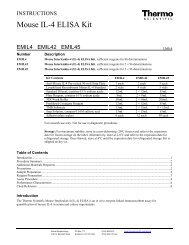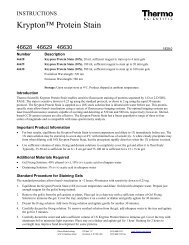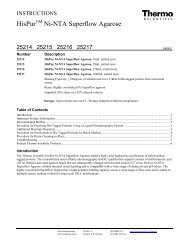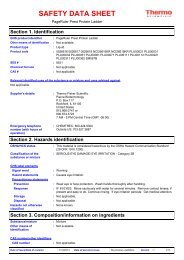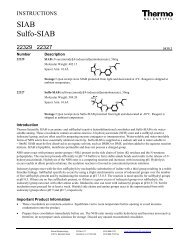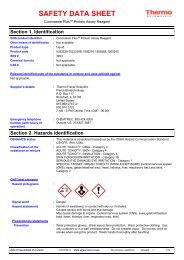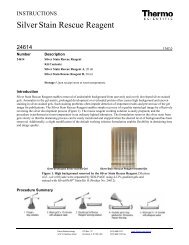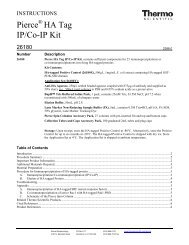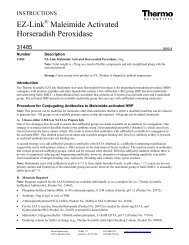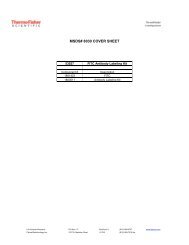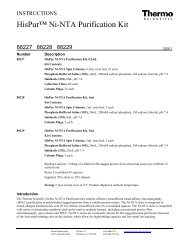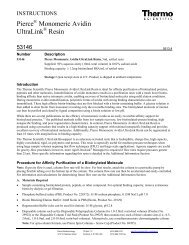Thermo Scientific Pierce Protein Assay Technical Handbook Version 2
Thermo Scientific Pierce Protein Assay Technical Handbook Version 2
Thermo Scientific Pierce Protein Assay Technical Handbook Version 2
Create successful ePaper yourself
Turn your PDF publications into a flip-book with our unique Google optimized e-Paper software.
Quick <strong>Technical</strong> Summaries – <strong>Thermo</strong> <strong>Scientific</strong> <strong>Protein</strong> <strong>Assay</strong>s<br />
Working Range<br />
(sample volume)* Characteristics/Advantages Applications Disadvantages Interfering Substances<br />
The Modified Lowry <strong>Protein</strong> <strong>Assay</strong><br />
Standard Protocol:<br />
1-1,500µg/mL<br />
Microplate Protocol:<br />
10-1,500µg/mL (40µL)<br />
Two-reagent system – shelf life of at least<br />
one year<br />
Two-step incubation requires precise<br />
sequential timing of samples<br />
Color response read at 750nm<br />
Works with peptides (three amino acids<br />
or larger)<br />
Lowry method is the most<br />
cited protein assay in the<br />
literature<br />
Adaptable for use with<br />
microplates<br />
Timed addition of Folin<br />
reagent adds complexity<br />
Longer total assay time<br />
Practical limit of about<br />
20 samples per run<br />
Detergents<br />
(cause precipitation)<br />
Thiols, disulfides<br />
Copper chelating reagents<br />
Carbohydrates including<br />
hexoseamines and their<br />
N-actyl derivatives<br />
<strong>Protein</strong>:protein variation similar to that seen<br />
with BCA Method<br />
Glycerol, Tris, Tricine, K 1+ ions<br />
Many authors have reported ways to deal<br />
with substances that interfere<br />
Coomassie Plus (Bradford) <strong>Assay</strong><br />
Linear Range:<br />
IgG: 125-1,500µg/mL<br />
BSA; 125-1,000µg/mL<br />
Standard Protocol:<br />
Sample-to-Reagent<br />
Ratio: 1:30<br />
Typical Working Range:<br />
100-1,500µg/mL (35µL)<br />
Microplate Protocol:<br />
Sample-to-Reagent<br />
Ratio: 1:1<br />
Typical Working Range:<br />
1-25µg/mL (150µL)<br />
Simple/fast protocols<br />
Total preparation and assay time < 30 minutes<br />
One reagent system; stable for 12 months<br />
Ready-to-use formulation — no dilution or<br />
filtration needed<br />
Nearly immediate color development at<br />
room temperature<br />
Linear color response in standard assay<br />
(more accurate results)<br />
Color response sensitive to changes in pH<br />
Temperature dependence of color response<br />
Compatible with buffer salts, metal ions,<br />
reducing agents, chelating agents<br />
Low-odor formulation<br />
Standard assay 8<br />
Micro assay 9,10,11<br />
Microplate format assay 12<br />
<strong>Assay</strong> of protein solutions<br />
containing reducing agents 13<br />
Quantitation of immobilized<br />
protein 14<br />
<strong>Protein</strong> in permeabilized<br />
cells 15<br />
NaCNBH 3 determination 16<br />
Less linear color response<br />
in the micro assay<br />
Effect of interfering<br />
substances more<br />
pronounced in the<br />
micro assay<br />
<strong>Protein</strong> dye complex has<br />
tendency to adhere to<br />
glass (easily removed<br />
with MeOH) 17<br />
<strong>Protein</strong> must be > 3,000 Da<br />
Detergents 18<br />
Coomassie (Bradford) <strong>Protein</strong> <strong>Assay</strong><br />
Standard Protocol: Simple-to-perform protocols<br />
Sample-to-Reagent<br />
One-reagent system, stable for 12 months<br />
Ratio: 1:50<br />
100-1,500µg/mL (20µL) Ready-to-use formulation<br />
Microplate Protocol: No dilution or filtration needed<br />
Sample-to-Reagent<br />
Fast, nearly immediate color development at<br />
Ratio: 1:1<br />
room temperature<br />
1-25µg/mL (150µL)<br />
Total preparation and assay time < 30 minutes<br />
Typical protein:protein variation expected for<br />
a Coomassie dye-based reagent<br />
Color response sensitive to pH<br />
Temperature-dependent color response<br />
Compatible with buffer salts, metal ions,<br />
reducing agents, chelating agents<br />
Standard assay 8<br />
Micro assay 9,10,11<br />
Microplate format assay 19<br />
<strong>Assay</strong> of protein solutions<br />
containing reducing agents<br />
Cell line lysates 20<br />
<strong>Protein</strong> recovery studies<br />
Nonlinear color response<br />
More protein standard<br />
concentrations required to<br />
cover working range<br />
Micro assay has potential<br />
for interference<br />
<strong>Protein</strong> must be > 3,000 Da<br />
Detergents 18<br />
* Sample volume per 1mL total assay volume for measurement in 1cm cuvette (Standard Protocol). Sample volume per 200-300µL total volume for measurement in 96-well microplate.<br />
2<br />
For more information, or to download product instructions, visit www.thermoscientific.com/pierce



